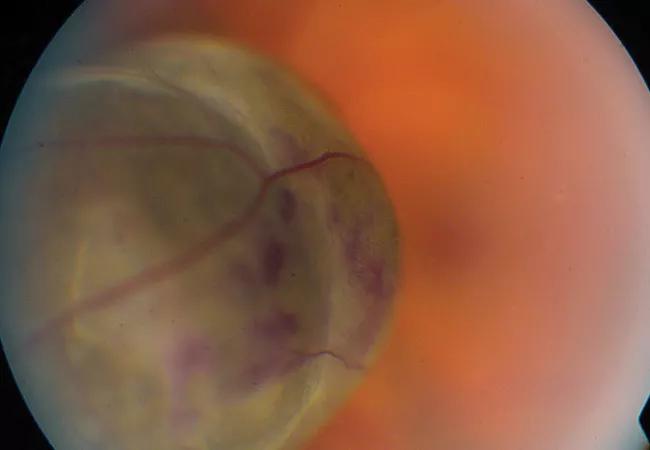USG can have high sensitivity for hepatic metastases

A retrospective cohort study of uveal melanoma patients at Cleveland Clinic’s Cole Eye Institute found that surveillance with hepatic ultrasonography (USG), followed by confirmatory scans, is highly likely to detect asymptomatic metastases. Researchers found that hepatic USG used for surveillance every six months, when followed by confirmatory scans, yielded a sensitivity and negative predictive value of 96 percent and 99 percent, respectively, for identifying asymptomatic metastases. This was reported in their research paper, published in JAMA Ophthalmology in December 2015 (Maria Choudhary, MD, Todd Emch, MD, Akshay Gupta, BS and James Bena, MS, Arun Singh, MD).
Cleveland Clinic is a non-profit academic medical center. Advertising on our site helps support our mission. We do not endorse non-Cleveland Clinic products or services. Policy
Researchers reviewed the charts of 263 uveal melanoma patients treated and followed from 2003 to 2012 at Cole Eye Institute. Patients received hepatic USG as well as liver function tests every six months.
Hepatic USG is known to have some limitations, including operator dependency, limited resolution and limited depth penetration in overweight individuals. To counter these limitations, the research team – led by Dr. Singh, Director, Ophthalmic Oncology, used confirmatory scans with MRI or CT to confirm abnormal results when necessary. Liver biopsy was performed only if the confirmatory scan was positive.
In the study, the specificity and positive predictive values of hepatic USG were low — 88 percent and 45 percent, respectively. Yet by using stepwise serial USG surveillance, researchers were able to improve these results. The results revealed that the specificity of the confirmatory scans was 93 percent — supporting the validity of the researchers’ stepwise approach.
Patients who undergo treatment for uveal melanoma have the highest risk for metastases within the first five years after treatment — and most of these metastases occur in the liver. With the availability of highly accurate prognostic testing for uveal melanoma and a trend toward adjuvant therapy, systemic staging at baseline followed by periodic surveillance for metastases is an increasingly important management strategy, researchers said.
In the study, 86 hepatic USGs (from 71 patients) were reported as abnormal. After hepatic USG, 13 lesions were identified as a cyst or hemangioma, 17 were reported as “indeterminate,” 36 were “suspicious for metastasis” and five patients had lesions consistent with metastases.
One lesion in the cyst/hemangioma group and one in the “indeterminate” group were found to be metastatic after all testing was complete. Biopsy also confirmed metastatic disease in 64 percent of the lesions identified by USG as “suspicious for metastases.” Biopsies also found metastatic disease in 100 percent of the lesions identified by hepatic USG as “consistent with metastases.”
Despite the accuracy of the study’s results in identifying pre-symptomatic metastases, these findings did not translate to a survival benefit for patients. The median overall survival in the study cohort was 35.9 months — similar to the survival of asymptomatic uveal melanoma patients in other research studies.
Still, the systemic surveillance provided in the study gives uveal melanoma patients reassurance while dealing with a frightening, life-threatening diagnosis, researchers said. Surveillance by hepatic USG with a stepwise approach also has a low risk for negative effects, such as complications from unnecessary invasive testing. Since the stepwise approach had a high negative predictive value of 99 percent in the study, unnecessary biopsies were limited. Only one patient in the study cohort tested with hepatic USG and confirmatory scan was negative for metastases after liver biopsy.
The researchers did not perform a detailed cost analysis of the hepatic USG testing they used, and cost effectiveness was not one of the primary outcomes measured in the study. Yet by consulting an online resource, the scientists were able to compare the cost of an abdominal USG scan with the cost of an abdominal CT and MRI at Cleveland Clinic. The USG scan was significantly cheaper for a self-pay patient — $140 compared to $825 for a CT scan, and $925 for an MRI scan.
These cost differences will vary in other cities across the United States, the researchers noted. But the study’s approach could be used by many U.S. medical centers, since it relied on varied USG operators and analysis by qualified radiologists, and did not specify a special hepatic USG protocol, they said.
Researchers noted that using hepatic USGs for surveillance of uveal melanoma should be tailored to each patient’s prognosis and the adjuvant therapy received. They recommended serial hepatic USGs followed by confirmatory scans prior to liver biopsy as a reliable stepwise surveillance method. Such a surveillance method offers a high likelihood of detecting asymptomatic metastases, although it does not confer a survival advantage, the scientists concluded.

An underdiagnosed condition in patients with cancer

Study demonstrates superior visualization of occult primary lesions

New device offers greater tumor control for malignant liver lesions

Cleveland Clinic researchers discover what drives – and what may halt – virus-induced cancer

First-ever U.S. population-level retrospective analysis reveals many patients with systemic mastocytosis need faster intervention

New program provides prehabilitation and rehabilitation services to help patients with cancer maintain and regain function

First-of-its-kind research investigates the viability of standard screening to reduce the burden of late-stage cancer diagnoses

Global R&D efforts expanding first-line and relapse therapy options for patients